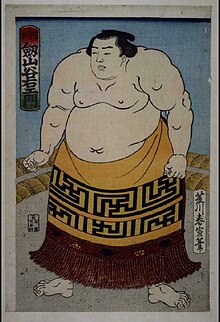Tsurugizan Taniemon II
| Tsurugizan Taniemon II | |
|---|---|
| 劔山 谷右エ門 | |
 | |
| Personal information | |
| Born | Kumakichi Harai January 20, 1852 Kamojima, Oe District, Japan |
| Died | November 21, 1910 (aged 58) |
| Height | 1.77 m (5 ft 9+1⁄2 in) |
| Weight | 120 kg (260 lb) |
| Career | |
| Stable | Inagawa → Ikazuchi |
| Record | 70-26-79-14 draws/1 hold |
| Debut | May, 1885 |
| Highest rank | Ōzeki (January, 1893) |
| Retired | January, 1886 |
| Elder name | Musashigawa |
| Championships | 1 (Makuuchi, unofficial) |
| * Up to date as of September, 2023. | |
Tsurugizan Taniemon (劔山 谷右エ門, January 20, 1852 – November 21, 1910) was a Japanese professional sumo wrestler from Kamojima, Oe District (now Awa, Tokushima Prefecture). His highest rank was ōzeki and he is one of only two wrestlers from this prefecture to have reached this rank, being the second overall and the first promoted since Eshimagata's promotion in 1778, 108 years earlier.[1]
History
[edit]Tsurugizan began his wrestling career by joining the Osaka-based sumo association thanks to a wrestler named Tsurugahama, a relation of his father. There, he joined Inagawa stable and started to wrestle in 1875 under the shikona, or ring name, Kyōya (響矢).[2] The following year, in 1876, there was however a breakout incident within the Osaka Sumo Association and Tsurugizan decided to join the secessionists. In 1878, he began to serve the group as a promotional ōzeki but decided to join back the Osaka association.[2] In 1882, he decided to join the Tokyo-based sumo association.
In 1883, he became a student of Umegatani, who was still an active wrestler at the time, in Ikazuchi stable and competed in the May tournament of the same year directly as a san'yaku-ranked wrestler.[2] He was given the shikona Tsurugizan (劔山) after a mountain in his home prefecture. In January 1884, he changed his name to Taniemon to bear the complete name of the eponymous ōzeki who wrestled during the Edo period. In May 1885, he was promoted to sekiwake and in January 1886, he was promoted to ōzeki in place of his master who retired. In 1891, he scooted a young boy and asked his master to recruit him within the stable, hence recruiting future-yokozuna Umegatani Tōtarō II.[3]
He retired in June 1892 and became an elder in the Sumo Association under the name Musashigawa, notably serving as a shimpan.[2] He died in November 1910 at the age of 58.
Career record
[edit]| - | Spring | Summer | ||||
|---|---|---|---|---|---|---|
| 1883 | Unknown | East Komusubi #2 4–1–4 1d |
||||
| 1884 | East Komusubi #1 6–1–2 1d |
East Komusubi #1 5–3–2 |
||||
| 1885 | East Komusubi #1 7–1–1 1d |
East Sekiwake #1 7–2–1 |
||||
| 1886 | East Ōzeki #1 7–1–1 1d |
East Ōzeki #1 7–1–1 1h Unofficial |
||||
| 1887 | East Ōzeki #1 0–0–10 |
East Ōzeki #1 4–1–3 2d |
||||
| 1888 | East Ōzeki #1 2–1–5 2d |
East Ōzeki #1 7–0–1 2d |
||||
| 1889 | East Ōzeki #1 5–1–3 1d |
East Ōzeki #1 0–0–10 |
||||
| 1890 | East Ōzeki #1 0–2–7 1d |
West Haridashi Ōzeki 0–0–10 |
||||
| 1891 | West Haridashi Ōzeki 2–5–3 |
West Haridashi Ōzeki 6–1–1 2d |
||||
| 1892 | West Haridashi Ōzeki 1–5–4 |
West Haridashi Ōzeki Retired 0–0–10 |
||||
| Record given as win-loss-absent Top Division Champion Retired Lower Divisions Key: d=Draw(s) (引分); h=Hold(s) (預り); nr=no result recorded Yokozuna (not ranked as such on banzuke until 1890) Ōzeki — Sekiwake — Komusubi — Maegashira |
||||||
*Championships for the best record in a tournament were not recognized or awarded before the 1909 summer tournament and the above championships that are labelled "unofficial" are historically conferred. For more information see yūshō.
See also
[edit]Sources
[edit]References
[edit]- ^ "Wrestlers from Tokushima Prefecture by rank". SumoDB. Retrieved 11 September 2023.
- ^ a b c d "剣山谷右衛門(2代)". Digital Edition Japanese Name Encyclopedia (in Japanese). Retrieved 20 September 2023 – via Kotobank encyclopedia.
- ^ "20th Yokozuna Umegatani Tōtarō - Time-Line". Ozumo database (in Japanese). Retrieved 20 September 2023.
- ^ "Tsurugizan Taniemon Rikishi Information". Sumo Reference. Retrieved 20 September 2023.
Further reading
[edit]- "「大相撲人物大事典」" [Sumo Personalities Encyclopedia]. Sumo Magazine. Baseball Magazine, Inc. January 2001. p. 725. ISBN 9784583036403.
